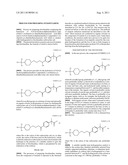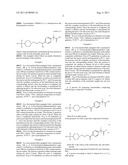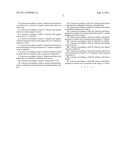Patent application title: Process for preparing fexofenadine
Inventors:
Giorgio Bertolini (Milano, IT)
Maurizio Gallina (Novara, IT)
Giuseppe Motta (Milano, IT)
Domenico Vergani (Biassono, IT)
IPC8 Class: AC07D21134FI
USPC Class:
546239
Class name: The chalcogen, x, is in a -c(=x)- group the -c(=x)- is part of a -c(=x)x- group, wherein the x's are the same or diverse chalcogens plural carbocyclic rings containing
Publication date: 2011-08-04
Patent application number: 20110190504
Abstract:
A process for preparing fexofenadine is described, which provides for the
hydrolysis of
4-[4-[4-(hydroxydiphenylmethyl)-1-piperidyl]-1-oxobutyl]-α,α--
dimethylbenzeneacetic acid-alkyl ester, in a mixture of water and
optionally an organic solvent, in the presence of a base; the carboxylate
salt of 4-[4-[4-(hydroxydiphenylmethyl)-1-piperidyl]-1-oxobutyl]-α,-
α-dimethylbenzeneacetic acid is thus obtained, which is then
directly reduced as carboxylate in a basic environment with hydrogen in
the presence of a suitable hydrogenation catalyst to give the carboxylate
of fexofenadine, which is precipitated by neutralisation of the solution.Claims:
1. A process for preparing fexofenadine comprising hydrolysing a compound
of formula ##STR00007## where R is an alkyl group, in the presence of a
base to give the compound of formula ##STR00008## where M.sup.+ is the
cation of the carboxylate salt, and subsequently hydrogenating the
compound of formula III to give fexofenadine.
2. A process according to claim 1, wherein R is a C1-C4 alkyl group.
3. A process according to claim 1, wherein said hydrolysis is carried out in a mixture of organic solvent and water or in water only.
4. A process according to claim 3, wherein said organic solvent is a polar organic solvent.
5. A process according to claim 3, wherein said organic solvent is a C1-C4 alcohol.
6. A process according to claim 3, wherein said organic solvent is present in ratios in the range of 0.25-16 volumes in relation to water.
7. A process according to claim 3, wherein said mixture of water and organic solvent is present in 6-7 volumes in relation to the compound.
8. A process according to claim 1, wherein said base is used in molar excess in relation to the compound of formula II.
9. A process according to claim 1, wherein said base is the hydroxide of an alkaline or alkaline-earth metal.
10. A process according to claim 1, wherein M.sup.+ is Na.sup.+.
11. A process according to claim 1, wherein said hydrogenation is carried out in the presence of a hydrogenation catalyst.
12. A process according to claim 11, wherein said catalyst is selected from palladium, platinum and ruthenium.
13. A process according to claim 11, wherein said catalyst is palladium supported on carbon.
14. A process according to claim 11, wherein said hydrogenation is carried out at a temperature between 0.degree. C. and the boiling point of the solvent.
15. A process according to claim 11, wherein said hydrogenation is carried out at a pressure in the range of 1-100 bar.
16. A process according to claim 2, wherein R is methyl.
17. A process according to claim 4, wherein said organic solvent is protic.
18. A process according to claim 5, wherein said organic solvent is methanol.
19. A process according to claim 8, wherein said base is used in molar ratio of from 3 to 5 in relation to the compound of formula II.
20. A process according to claim 9, wherein said base is NaOH.
21. A process according to claim 15, wherein said hydrogenation is carried out at a pressure in the range of 1-10 bar.
Description:
[0001] Process for preparing fexofenadine comprising the hydrolysis of
4-[4-[4-(hydroxydiphenylmethyl)-1-piperidyl]-1-oxobutyl]-α,α--
dimethylbenzeneacetic acid-alkyl ester to
4-[4-[4-(hydroxydiphenylmethyl)-1-piperidyl]-1-oxobutyl]-α,α--
dimethylbenzeneacetic acid which is catalytically hydrogenated as
fexofenadine carboxylate salt.
[0002] The present invention concerns a process for preparing fexofenadine, the formula of which is shown below.
##STR00001##
[0003] The process provides for the hydrolysis of 4-[4-[4-(hydroxydiphenylmethyl)-1-piperidyl]-1-oxobutyl]-α,α-- dimethylbenzeneacetic acid-alkyl ester, also shown below,
##STR00002##
where R is an alkyl group, in a mixture of water and optionally an organic solvent, in the presence of a base, by obtaining the carboxylate salt of 4-[4-[4-(hydroxydiphenylmethyl)-1-piperidyl]-1-oxobutyl]-α,- α-dimethylbenzeneacetic acid, shown below,
##STR00003##
where M+ is the cation of the carboxylate salt (or, in other words, the cation of the base used for the hydrolysis), which is directly reduced as carboxylate in a basic environment with hydrogen in the presence of a suitable catalyst to give the carboxylate of fexofenadine, which is precipitated by neutralisation of the solution.
PRIOR ART
[0004] The processes of preparing fexofenadine starting from the compound of formula II reported in the literature describe as a preferred method of ketone group reduction the reduction with sodium borohydride as, for example, described in U.S. Pat. No. 4,254,129. This reaction may be carried out before or after the ester hydrolysis. The methods of catalytic reduction mentioned are described as less efficient. These reactions are conducted in organic solvents on the compound of Formula II or its relative acid. Under these conditions, the reaction yields have proven to be quite low because of the formation of an impurity caused by the complete hydrogenolysis and the loss of one or both oxygens at benzyl position and which makes up about 32% of the product deriving from the hydrogenolysis.
DESCRIPTION OF THE INVENTION
[0005] In the new process, the compound of FORMULA II
##STR00004##
where R is an alkyl group, preferably a C1-C4 alkyl group, still more preferably methyl, is dissolved or suspended in a mixture of organic solvent and water, in the presence of a base, or in water and base only, and hydrolysed under stirring at a temperature comprised between 0° C. and the reflux temperature of the mixture. The organic solvent is preferably a polar solvent, normally of a protic type, preferably a C1-C4 alcohol, still more preferably methanol. The base is preferably of an inorganic nature, such as, for example, the hydroxide of an alkaline or alkaline-earth metal, still more preferably NaOH.
[0006] Said organic solvent, when used, is present in ratios in the range of 0.25-16 volumes in relation to water; or said mixture of water and organic solvent is preferably present in 6-7 volumes in relation to compound II; the base, in turn, is preferably used in molar excess in relation to the compound of formula II, preferably with a molar ratio from 3 to 5.
[0007] The compound of FORMULA III is obtained from this reaction
##STR00005##
where M+ is the cation of the carboxylate salt, preferably Na.sup.+.
[0008] A suitable metallic-type hydrogenation catalyst is added to the system thus obtained, preferably selected from suitably supported palladium, platinum, or ruthenium (preferably palladium on carbon) and is hydrogenated at a temperature between 0° C. and the boiling point of the solvent at a pressure in the range of 1-100 bar, preferably 1-10 bar.
[0009] Fexofenadine, FORMULA I, is obtained from the hydrogenation reaction
##STR00006##
which is then precipitated by neutralising the base present in solution with an acid, preferably acetic acid.
[0010] The examples which follow are purely illustrative and non limiting of the invention.
Example 1
[0011] In a four-necked flask equipped with a mechanical stirrer, 100 g of 4-[4-[4-(hydroxydiphenylmethyl)-1-piperidyl]-1-oxobutyl]-α,α-- dimethylbenzeneacetic acid-methyl ester, 600 ml of methanol and 60 ml of 30% sodium hydroxide are loaded. The mixture is heated at reflux and kept under stirring for about 5 hours. When the ester is completely hydrolysed, 10 g of 5% palladium on carbon are loaded into the reactor and are hydrogenated at 50° C. and 6 bar pressure until the complete conversion of the benzylketone into the corresponding alcohol. Once the reaction is completed, the catalyst is filtered and the fexofenadine is precipitated by adjusting the pH to 5-8 with acetic acid. The solid obtained is filtered and dried under vacuum at 65° C.
[0012] 85 g of crude fexofenadine are obtained on average with HPLC purity >99%. Optimum temperature for hydrogenation: 35-45° C.; pH of precipitation 5-6.
Example 2
[0013] In a four-necked flask equipped with a mechanical stirrer, 100 g of 4-[4-[4-(hydroxydiphenylmethyl)-1-piperidyl]-1-oxobutyl]-α,α-- dimethylbenzeneacetic acid-methyl ester, 600 ml of water, 150 ml of Isopropanol and 73 ml of 30% sodium hydroxide are loaded. The mixture is heated at reflux and kept under stirring for about 5 hours. When the ester is completely hydrolysed, 10 g of 5% palladium on carbon are loaded into the reactor and are hydrogenated at 50° C. and 6 bar pressure until the complete conversion of the benzylketone into the corresponding alcohol. Once the reaction is completed, the catalyst is filtered and the fexofenadine is precipitated by adjusting the pH to 5-8 with acetic acid. The solid obtained is filtered and dried under vacuum at 65° C.
[0014] 85 g of crude fexofenadine are obtained on average with HPLC purity >99%. Optimum temperature for hydrogenation: 35-45° C.; pH of precipitation 5-6.
Example 3
[0015] In a four-necked flask equipped with a mechanical stirrer, 100 g of 4-[4-[4-(hydroxydiphenylmethyl)-1-piperidyl]-1-oxobutyl]-α,α-- dimethylbenzeneacetic acid-methyl ester, 600 ml of methanol and 60 ml of 30% sodium hydroxide are loaded. The mixture is heated at reflux and kept under stirring for about 5 hours. When the ester is completely hydrolysed, 10 g of 5% palladium on carbon are loaded into the reactor and are hydrogenated at 50° C. and 10 bar pressure until the complete conversion of the benzylketone into the corresponding alcohol. Once the reaction is completed, the catalyst is filtered and the fexofenadine is precipitated by adjusting the pH to 5-8 with acetic acid. The solid obtained is filtered and dried under vacuum at 65° C.
[0016] 85 g of crude fexofenadine are obtained on average with HPLC purity >99%. Optimum temperature for hydrogenation: 35-45° C.; pH of precipitation 5-6.
Example 4
[0017] In a four-necked flask equipped with a mechanical stirrer, 100 g of 4-[4-[4-(hydroxydiphenylmethyl)-1-piperidyl]-1-oxobutyl]-α,α-- dimethylbenzeneacetic acid-methyl ester and 600 ml of methanol are loaded. When the ester is completely solubilised, 10 g of 5% palladium on carbon are loaded into the reactor and are hydrogenated at 50° C. and 6 bar pressure until the complete conversion of the benzylketone into the corresponding alcohol. Once the reaction is completed, the catalyst is filtered, 60 ml of 30% sodium hydroxide are added and the mixture is heated at reflux and kept under stirring until the complete hydrolysis of the ester, about 5 hours. The fexofenadine is precipitated by adjusting the pH to 5-8 with acetic acid. The solid obtained is filtered and dried under vacuum at 65° C.
[0018] 55 g of fexofenadine are obtained with HPLC purity of about 60% and an impurity with A % equal to 32, which, from the calculation of the molecular weight, has one less oxygen.
User Contributions:
Comment about this patent or add new information about this topic:



